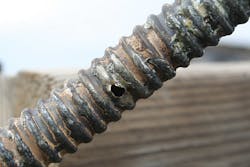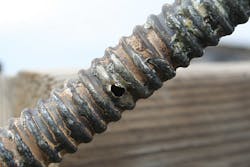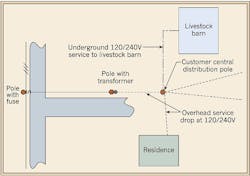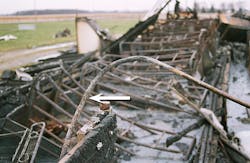When a plumbing contractor installed flexible corrugated stainless steel tubing (CSST) in a livestock barn in order to supply propane to ceiling-mounted heaters, he had no reason to envision the tragedy that would ultimately unfold. Little did he know that three years later, a high-voltage electric utility wiring short circuit nearby (approximately 500 ft from the barn) would cause the tubing to perforate and ignite combustibles in the ceiling area of the barn, starting a fire that resulted in total loss of the building as well as the livestock inside.
When a truck veered off the right side of a two-lane road and struck a wood utility pole in an attempt to avoid a vehicle stopped in the roadway, the damage resulted in a 7,200V overhead wire falling to the ground and coming in contact with the electric utility neutral wire. Moments later, an individual turning left onto the farm driveway noticed smoke coming from the barn. He immediately ran to the structure and observed flames coming from the CSST line on the south wall ceiling area, and quickly shut off the propane supply to the building. During the investigation that followed, a perforation in the CSST in the area of origin was identified as the cause of the fire.
The scene
The livestock barn was one of many buildings located on this Midwestern property, which included a residence. As is commonly done on farms, the home and structures were provided power at 120/240V from a central customer-owned pole (Figure). An electric utility pole with a transformer was located approximately 70 ft away from the central distribution pole. The high-voltage wire on the transformer pole ran along the farm driveway to the pole on the opposite side of the roadway that was struck by the vehicle. The barn where the fire was discovered was located more than 300 ft from the central distribution pole, and was fed power through underground wiring. The electric utility transformer was grounded with a resistance of 17 ohms, and the 120/240V customer service was grounded with two rod electrodes, measuring 15.8 and 16.5 ohms.
The barn, featuring a pitched roof and corrugated metal walls, contained three propane heaters mounted in the ceiling area. A propane tank was located at the rear of the structure, and a copper tube extended underground to the livestock barn. The ground resistance of the copper propane tube measured 3.2 ohms. At the south rear side of the barn, the plumber converted to CSST from copper tubing and routed the CSST along the exterior of the corrugated wall to an opening near the propane overhead heater. Evidence indicates the perforation of the CSST was at a location where it routed through the corrugated wall in the southwest corner (Photo 1 and Photo 2).
The lawsuit
The law firm representing the plumbing contractor (defendant) retained our firm to investigate the incident and determine if he had contributed to the CSST perforation by violating existing electrical and fuel gas codes and/or manufacturer’s installation instructions.
Investigation and analysis
In the case of this fire, the perforation of the CSST was found at a bend in the flexible tubing, which is consistent with where it entered the barn through a hole in the corrugated metal wall. The aluminum south wall was destroyed by the fire, as was the polyethylene coating on the CSST. However, CSST was present through an opening in the north wall — where no perforation occurred (Photo 3).
Based on reference material and research from the NFPA and Los Alamos National Laboratory, the melting temperature range for 304 stainless steel used for CSST is between 2,550°F to 2,650°F, while temperatures of wood structure fires are reported to reach up to 1,880°F. Aluminum has a melting temperature of 1,220°F, while temperatures of electrical arcing are in the range of several thousand degrees Fahrenheit. This helped us derive two findings. The temperature of the fire could reach a sufficient level to melt the aluminum corrugated wall, but would not be sufficient to melt the stainless steel CSST. As a result, when a perforation of CSST occurs, it is likely that an arc has occurred that generated sufficient heat to melt the steel at that point. Potential causes for this arc are either contact with an energized wire or surface causing a short circuit condition, or a transient elevated voltage condition occurred that energized conductive surfaces near the CSST, such as a lightning strike (see Event Significance).
In this case, lightning was not detected in the vicinity of this location at or shortly prior to the fire event; therefore, it was not a probable cause. Copper has a melting temperature of approximately 1,980°F, and typically survives a structure fire. Arc mapping is the identification of the location of arcing events in the wiring system, which can be a useful method for analyzing fire origination and spread. No arcing was identified on any branch circuits in the vicinity of the area of origin, which ruled out an electrical short circuit condition with the CSST.
The location of this short circuit — due to the vehicle accident — was 2.6 miles from the substation, and the maximum available phase-to-ground fault current was 1,380A. This electric distribution circuit is a 3-phase wye circuit, operating at 12,470/7,200V. The single-phase 7,200V tap to the transformer on the farm property was fused at the pole struck by the vehicle.
The manufacturer’s design and installation guide indicates that “the protective plastic jacketing should be kept in place as much as possible to protect the tubing from corrosive threats.” There is no indication that this plastic jacketing is intended to provide electrical insulation of the tubing. Although the electric utility fuse would open as a result of the short circuit condition, fuses take some time before opening. As a result, a short-duration (or transient) condition can exist on the system during the time prior to the fuse opening. My investigation concluded that the CSST arced to the corrugated metal wall at the opening when the electric utility fault occurred, with the elevated voltage causing perforation of the CSST and resulting structure fire.
The outcome
In order to determine liability of the plumbing contractor, I consulted the required building codes and manufacturer’s instructions that were in place at the time of this installation. The codes adopted by the municipality were the 2003 International Fuel Gas Code (IFGC) and the 2002 National Electrical Code (NEC). In addition, the manufacturer’s 2002 installation guide and ANSI LC 1b-2001 (Fuel Gas Piping Systems Using CSST) were also applicable.
Article 250.104(4)(B) of the 2002 NEC states, “Where installed in or attached to a building or structure, metal piping system(s), including gas piping, that may become energized shall be bonded to the service equipment enclosure, the grounded conductor at the service, the grounding electrode conductor where of sufficient size, or to the one or more grounding electrodes used. The bonding jumper(s) shall be sized in accordance with 250.122 using the rating of the circuit that may energize the piping system(s). The equipment grounding conductor for the circuit that may energize the piping shall be permitted to serve as the bonding means.” In this case, the branch circuit supplying power was a 3-wire cable with a ground wire that was attached to the heater.
Article 310 of the 2003 IFGC states,“Each above-ground portion of a gas piping system that is likely to become energized shall be electrically continuous and bonded to an effective ground-fault current path. Gas piping shall be considered to be bonded where it is connected to gas utilization equipment that is connected to the equipment grounding conductor of the circuit supplying that equipment.” This was the same language documented in the manufacturer’s 2002 design and installation guide.
The installer, who was also the plumbing contractor, is responsible for installing in accordance with the codes adopted by the municipality at the time of installation as well as the manufacturer’s instructions, which he did. See Grounding and Bonding for Fuel Gas and Electrical Systems for more details.
Lessons learned
In recent years, code officials and manufacturers have changed the language of codes and installation instructions to require the fuel gas system to be bonded at the load side of the gas meter with a No. 6 AWG copper wire to the electrical system grounding electrode. IFGC and CSST manufacturers’ instructions no longer accept the branch circuit grounding electrode attachment as sufficient. But some disagreement still exists on what is considered the proper size of a bonding electrode for fuel gas piping systems.
The use of CSST will likely continue to be challenged as a product that isn’t fit for its intended purpose due to the thin wall and limited energy it can withstand. When challenged, manufacturers point to the ability of the CSST to move with shifting buildings without developing a dangerous leak. At least one manufacturer now offers a product that is promoted for guarding against damage from lightning, indicating that the combination of materials and construction are designed to better withstand arcing.
Vandal is an electrical forensic engineer with LWG Consulting in San Jose, Calif. A certified fire and explosion investigator (CFEI), he can be reached at [email protected].
SIDEBAR 1: Event Significance
Structure fires related to CSST perforation from arcing due to lightning events have been, and continue to be, documented in the United States. The damaging effects of lightning strikes to structures occur on a frequent basis, resulting in significant property damage and related insurance costs. The Fire Protection Research Foundation conducted research on lightning-related CSST damage in support of the National Fire Protection Association and published its findings in April 2011 in “Validation of Installation Methods for CSST Gas Piping to Mitigate Lightning Related Damage, Final Report.” Having researched this and other information regarding susceptibility of CSST fires related to lightning incidents, the author isn’t aware of reports of fire damage due to arcing and perforation of CSST where the elevated voltage isn’t attributed to a lightning event.
SIDEBAR 2: Grounding and Bonding for Fuel Gas and Electrical Systems
CSST is a building product used to distribute fuel gas in a structure in place of, or in addition to, conventional black steel pipe. The flexibility of the tube, minimal number of connections, and lack of threading result in labor savings relative to rigid black pipe. CSST consists of stainless steel corrugated tubing with a wall thickness between 0.008 in. and 0.01 in. (dependent on manufacturer) that is sheathed by various types of coatings. In comparison, a typical schedule 40, ½-in. OD black steel pipe has a wall thickness of 0.109 in. The CSST tubing was recognized by ANSI/IAS LC-1 - 1997, and was first recognized by the National Fuel Gas Code in 1989.
Structure fires resulting from perforation of CSST and ignition of fuel gas from arcing have brought a renewed focus on adequate grounding and bonding practices for fuel gas and electrical systems. Arcing between metal objects in a structure occurs because of a voltage difference between the two conductive surfaces. In a residential structure, CSST is typically routed in close proximity to HVAC ducts, electrical wiring, copper HVAC condensate lines, and steel structural beams. In order to arc between CSST and one of these other conductive materials, sufficient energy is needed to bridge the air gap of the distance between them. Lightning has tremendous energy that is capable of bridging these gaps, which is why bonding of these conductive components may aid in minimizing voltage imbalances between these surfaces. In addition to bonding, dissipation of the energy through adequate grounding is also well known. The National Electrical Code (NEC) requires the resistance of the grounding electrode not to exceed 25 ohms, while testing indicates that grounded CSST produces less arcing and charge transfer.
Arcing and charge transfer are important factors with respect to damaging the CSST. Arcing causes extreme localized heating at the arc termination location, such as the CSST surface. Research indicates that the amount of damage to the metal surface can be correlated to electrical charge delivered or the amount of charge transferred by the arc and the duration over which the arc is active. The energy (heat capacity) required to create a perforation is based on the mass of the material. In other words, thinner metals require less heat energy to burn and create a hole.




